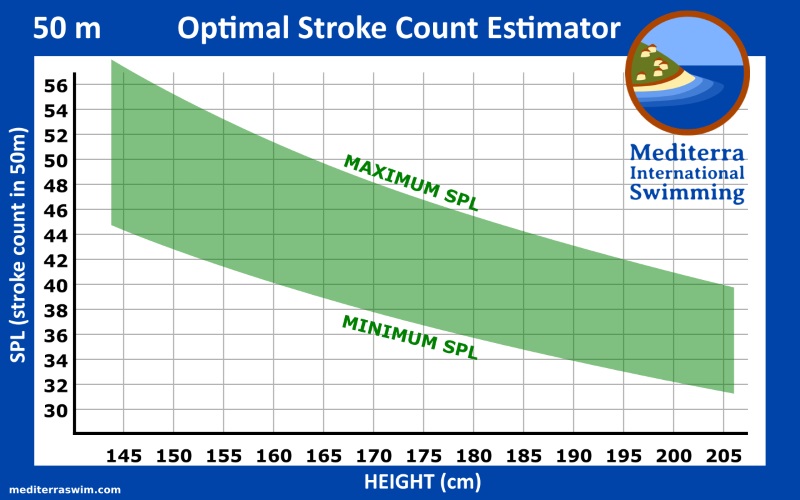Forums › Library › Knowledge Base › Optimal Stroke Count Estimator
Please type your comments directly in the reply box - DO NOT copy/paste text from somewhere else into the reply boxes - this will also copy the code behind your copied text and publish that with your reply, making it impossible to read. Our apology for the inconvenience, but we don't see a convenient way of fixing this yet.
Tagged: height, SPL, stroke counting, wingspan
-
AuthorPosts
-
June 4, 2019 at 12:09 #22301
Admin Mediterra
KeymasterThese charts will help you estimate your optimal Stroke Count, or in technical terms, your Strokes-Per-Length (SPL) range.
25 Meter Pool
This chart is for SPL in a 25 meter pool, assuming you take a 5 meter from push-off to first stroke.
25 Yard Pool
This chart is for SPL in a 25 yard pool, assuming you take a 5 yards from push-off to first stroke.
50 Meter Pool
This chart is for SPL in a 50 meter pool, assuming you take a 5 meter from push-off to first stroke.
Terminology
In Mediterra’s style of practices, when we refer to SPL, we will use a variable like “SPL N”, or “N-1”, or “N+1”, etc.
N = the lowest number in your appropriate SPL Range. It’s not the lowest SPL you can possibly achieve, but the lowest within the range of appropriate SPL for your continuous swimming – in that range that is good for your energy use and shoulder health.
If you have an SPL Range of 16 to 19, then your SPL N = 16, N+1 = 17, N+2 = 18, N-1 = 15, etc.
How These Curves Are Calculated
Based on a great deal of observation and comparison of data we see a strong case for setting a swimmer’s SPL range between 55% and 70% of their wingspan. The minimum SPL on this chart corresponds to 55% of height and the maximum corresponds to 70%. We chose to use height for these charts because most people know immediately what their height is, and for estimation purposes, that is close enough.
Wingspan is the measurement of your arms spread wide, measured from finger tip to finger tip. Wingspan provides the more accurate estimate of what your stroke length potential is. In humans height is approximately the same as wingspan, within +/- 5% margin of difference. We see this difference between height and wingspan also matters but we’ll save that discussion for another article.
Precise Personal Metrics
So if you want to do the math to get more precise, personalized SPL for yourself you need this data:
- Your wingspan or height (W)
- Your pool length (PL)
- The distance of your glide (pushoff) to stroke #1 (DG)
Then we start the calculations working with Stroke Length (SL).
Calculate your minimum 55% SL:
- W x .55 = min SL
Calculate your maximum 70% SL:
- W x .70 = max SL
Then we convert to SPL which is dependent on your pool length and glide:
Calculate your minimum SPL:
- (PL – DG) / max SL = min SPL
Calculate your maximum SPL:
- (PL – DG) / min SL = max SPL
Push-Off Matters
Some things to keep in mind as you use Stroke Counting…
How far you glide after pushing off from the wall to your first stroke affects your stroke count. If you followed the math calculations above you’ll notice that a short push-off will require you to take an extra stroke or two to reach the far wall, while a long one will allow you to take one or two strokes less.
Work on keeping this push-off and glide distance consistent on every lap. If you have a long glide (5-6 meters) you can aim for a lower end of your SPL range. If you have a shorter glide (3-4 meters) you can aim for the higher end of your SPL range. 4-5 meter push-off to glide is a good average to aim for.
Narrow Your Range
This chart estimates a range of about 5 SPL counts. However, through testing and practice we recommend that you narrow your personal range down to 3 SPL counts.
For example, for a male swimmer about 40 years old, 180 cm tall, the chart above suggests a 16-20 SPL in a 25 meter pool. If he has highly developed streamline and stroke efficiency he may aim for 16-18 SPL as his target SPL range. If less developed he may aim for 18-20 SPL.
What Is Your SPL Range Used For?
They function a bit like multiple gears on your bicycle, allowing you to adjust the pressure and frequency to use energy just the way you need to for a particular event or conditions.
Your higher SPL count is generally for shorter distance, higher tempo, or lighter pressure strokes.
Your lower SPL count is generally for longer distances, lower tempo, or higher (steady) pressure strokes.
***
-
AuthorPosts
- You must be logged in to reply to this topic.



